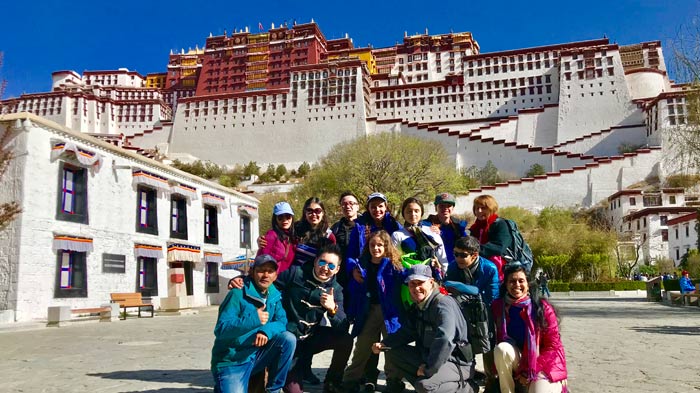Visit Lhasa: the most complete guide to Lhasa travel in 2019
Lhasa is the capital city and center of administration for the Tibet Autonomous Region of China, and lies in the south-central area of the Tibetan plateau. At an altitude of 3,656 meters above sea level, it is the world’s highest capital city, and the center of the Tibetan culture and religion.
The center of the Tibetan Empire for more than 300 years, and the heart of the Tibetan Buddhist religion for more than a millennium, Lhasa is a city of delights and wonders that will amaze and astound you. Literally meaning “place of the gods”, the city is also known as the City of Sunshine, and gets more than 8 hours of sunshine per day on average throughout the year.
Best Time to Visit Lhasa
Traveling to Lhasa can be done at any time of the year, from April to next-February (Tibet is normally closed to international travelers in mid-February and March for Losar, the Tibetan New Year), and when to go largely depends on your own personal tastes and what you want to do while you are there.

Different seasons have different attractions in Tibet, and even in the coldest month of January, travel to Lhasa is easily possible, and not as cold as you may think. Spring and autumn are normally the best months to travel to Lhasa for the clearer skies and best views, and if trekking is your thing, then there is no better time of year to do it. With almost no rainfall in spring and autumn, and temperatures that are mild to warm, trekking from Ganden Monastery to Samye Monastery or taking the hermitage trail around the foothills of the Nyenchen Tanglha Mountains around Lhasa is best done at these times of year.
Summer is the peak tourist season in Tibet, and in Lhasa it is the most popular time of year as well. Summer is warmer than the rest of the year, with higher temperatures that can reach as high as 23-25 degrees during the daytime. Nights can still be a little cold, but are manageable with a few warm sweaters to wear. Summer is also the monsoon season, and can be a little wetter than the west and north of Tibet, though not as wet as the eastern areas of Nyingchi. Monsoon rains normally fall in the late evenings and overnight, though, leaving the daytimes mostly dry and suitable for touring the sights of this stunning capital.
Winter is normally considered to be too cold to visit Tibet by many people, though they are misguided in their beliefs. While the temperature in some parts of Tibet can get to well below freezing at night, and not even get above freezing during he day, in Lhasa the temperatures are rarely that low during the daytime, and even at night do not get too far below zero. Snow fall in Lhasa normally occurs in late January and February, which means that there is little to worry about in terms of getting snowed in.
Winter is also the lowest season for tourism, and there are very few tourists that are prepared to travel to the plateau in late December and January. This means that many of the hotels and guesthouses offer off-peak discounts to attract the tourists that are wise enough to know that winter in Lhasa is an amazing time of year. Discounts are also available on the flights and trains to Tibet, as well as many of the attractions offering lower entry fees in the winter months. A great time to travel for budget travelers, Tibet is the ideal winter getaway. Here we offer you a couple of classic Tibet Lhasa winter tours for you to choose.
Travel Documents Needed for Visiting Lhasa
There are a number of travel permits that you need when traveling to Tibet, but if you are only visiting Lhasa, then that number is reduced to just one. Aside from your Chinese Entry Visa, which you will need to get into China from your home country before traveling to Tibet, the only permit you will need is the Tibet Travel permit, the main one for entering and traveling around the region.
Attractions you may also like:
Tibet Group Tour
-
12 Days Lhasa-EBC-Namtso-Nyingchi Group Tour from $1150
-
9 Days Classic Trip to EBC with Namtso Lake from $895
-
5 Days Lhasa-Namtso-Lhasa Group Tour from $568
-
7 Days Central Tibet Group Tour with Namtso from $712
-
4-Day Lhasa Join-in Group Tour from $356
-
5 Days Lhasa Group Tour with Yamdrok Lake from $530
-
5 Days Lhasa Pilgrimage Tour to Ganden Monastery & Drak Yerp from $530
-
6 Days Lhasa Shigatse Clssic Group Tour from $620
-
7 Days Overland Tour from Lhasa to Kathmandu from $780
- Lhasa Travel Guide
- Shigatse Travel Guide
- Nyingchi Travel Guide
- Ngari Travel Guide
- Lhokha Travel Guide
- Nagchu Travel Guide
- Chamdo Travel Guide
- Tibetan Culture
- Tibet Weather
- Tibet Map
- Tibet Tourism News